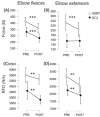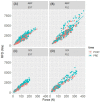Upper-Limb Muscle Fatigability in Para-Athletes Quantified as the Rate of Force Development in Rapid Contractions of Submaximal Amplitude
- PMID: 38921644
- PMCID: PMC11204935
- DOI: 10.3390/jfmk9020108
Upper-Limb Muscle Fatigability in Para-Athletes Quantified as the Rate of Force Development in Rapid Contractions of Submaximal Amplitude
Abstract
This study aimed to compare neuromuscular fatigability of the elbow flexors and extensors between athletes with amputation (AMP) and athletes with spinal cord injury (SCI) for maximum voluntary force (MVF) and rate of force development (RFD). We recruited 20 para-athletes among those participating at two training camps (2022) for Italian Paralympic veterans. Ten athletes with SCI (two with tetraplegia and eight with paraplegia) were compared to 10 athletes with amputation (above the knee, N = 3; below the knee, N = 6; forearm, N = 1). We quantified MVF, RFD at 50, 100, and 150 ms, and maximal RFD (RFDpeak) of elbow flexors and extensors before and after an incremental arm cranking to voluntary fatigue. We also measured the RFD scaling factor (RFD-SF), which is the linear relationship between peak force and peak RFD quantified in a series of ballistic contractions of submaximal amplitude. SCI showed lower levels of MVF and RFD in both muscle groups (all p values ≤ 0.045). Despite this, the decrease in MVF (Cohen's d = 0.425, p < 0.001) and RFDpeak (d = 0.424, p = 0.003) after the incremental test did not show any difference between pathological conditions. Overall, RFD at 50 ms showed the greatest decrease (d = 0.741, p < 0.001), RFD at 100 ms showed a small decrease (d = 0.382, p = 0.020), and RFD at 150 ms did not decrease (p = 0.272). The RFD-SF decreased more in SCI than AMP (p < 0.0001). Muscle fatigability impacted not only maximal force expressions but also the quickness of ballistic contractions of submaximal amplitude, particularly in SCI. This may affect various sports and daily living activities of wheelchair users. Early RFD (i.e., ≤50 ms) was notably affected by muscle fatigability.
Keywords: disability; explosive strength; fatigability; sport.
Conflict of interest statement
The authors declare no conflicts of interest.
Figures







Similar articles
-
Analysis of the rate of force development reveals high neuromuscular fatigability in elderly patients with chronic kidney disease.J Cachexia Sarcopenia Muscle. 2023 Oct;14(5):2016-2028. doi: 10.1002/jcsm.13280. Epub 2023 Jul 13. J Cachexia Sarcopenia Muscle. 2023. PMID: 37439126 Free PMC article.
-
Neuromuscular Fatigue Does Not Impair the Rate of Force Development in Ballistic Contractions of Submaximal Amplitudes.Front Physiol. 2018 Oct 24;9:1503. doi: 10.3389/fphys.2018.01503. eCollection 2018. Front Physiol. 2018. PMID: 30405448 Free PMC article.
-
Strength, Rate of Force Development, and Force Control Evaluations to Quantify Upper-Limbs Asymmetries Agreement in Professional Male Volleyball Players.J Strength Cond Res. 2025 Apr 1;39(4):466-473. doi: 10.1519/JSC.0000000000005025. Epub 2024 Dec 19. J Strength Cond Res. 2025. PMID: 39705112
-
Rate of Force Development as an Indicator of Neuromuscular Fatigue: A Scoping Review.Front Hum Neurosci. 2021 Jul 9;15:701916. doi: 10.3389/fnhum.2021.701916. eCollection 2021. Front Hum Neurosci. 2021. PMID: 34305557 Free PMC article.
-
The rate of force development scaling factor: a review of underlying factors, assessment methods and potential for practical applications.Eur J Appl Physiol. 2022 Apr;122(4):861-873. doi: 10.1007/s00421-022-04889-4. Epub 2022 Jan 19. Eur J Appl Physiol. 2022. PMID: 35048184 Review.
References
LinkOut - more resources
Full Text Sources

